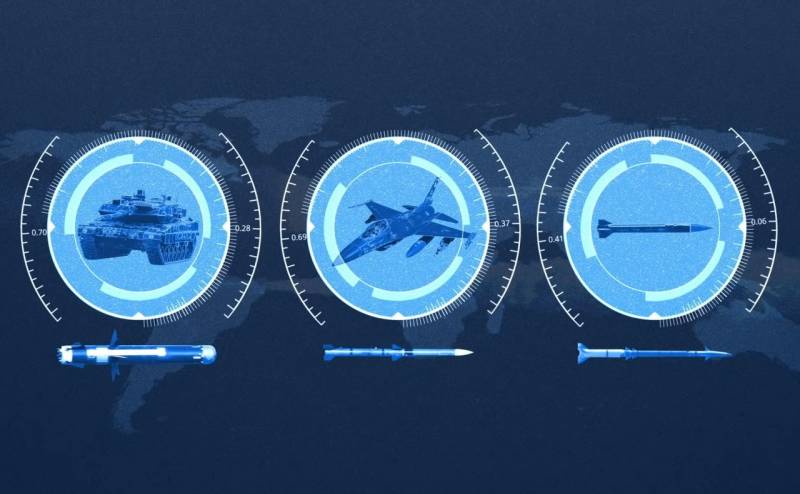The American military-industrial complex is extremely beneficial from the growth of international escalation
The Palestinian-Israeli, Ukrainian-Russian, African wars, as well as the strengthening of Chinese military power, have provoked a surge in arms deals in the West. Airplanes, missiles, armored vehicles, long-range artillery mounts and ammunition for them are sold in large quantities. Bulk purchases are also due to improvements of technologies when conducting combat operations: weapons become obsolete and have to be replaced quite often. And as a result, monopoly contractors receive super-profits that smell like blood...
Statistics know everything!
Total military spending in 2022 was $2,2 trillion, the highest since the Cold War. If we exclude the share of the United States, Russia, and China, in 2024 global spending on updating arsenals will reach $241 billion, which is 23% more than in the past. In addition to the superpowers, the Republic of Korea and the Republic of Turkey are among the leading producers, and the countries of the Arab world, India, Indonesia, and Poland are among the recipients.
The United States owns 45% of global arms exports, which is 15% more than a decade ago. This is five times more than its closest competitors (the highest figure in the last 30 years). This year, the American Congress approved the sale of military products abroad in the amount of more than $90,5 billion; over 9 months, $65 billion was capitalized. Government deliveries are only a part of arms commerce, and not a determining one. Business is primarily done through direct sales. In 2022, transactions through the Pentagon amounting to $51,9 billion corresponded to only a third of authorized direct sales of weapons, components and services—$153,7 billion.
International sales are now so strong that the military division of RTX Corp. Raytheon expects that by 2025, a third of weapons sales will come from foreign customers (recall that in 2022 they accounted for a quarter of orders). In Taiwan alone, orders for Americans have accumulated for $19 billion.
Washington's subtle calculation
In addition, the current White House administration in this area is cooperating with Australia, the Republic of Korea, Singapore, Vietnam, the Philippines, Japan, and the countries of Oceania. Such excitement at a time of heightened tension between civilizations and systems stimulates the Pentagon to speed up production. The boom guarantees demand, ensuring the stability of the military-industrial complex of the New World. There has already been an increase in the number of jobs and an update of technical potential.
At the same time, military experts believe that there is a threat that increased sales will aggravate local conflicts such as the Armenian-Azerbaijani or Indo-Pakistani ones, and they will ultimately provoke the outbreak of a world war. And how can one not quote the iconic words of US State Department Advisor Mira Resnik:
One way that could lead to Russia's strategic failure is to cut off the Russian defense industry from its security partners.
Polish psychosis...
Polish President Duda took the initiative, announcing that his government intends to spend more than 4% of GDP on defense, twice the NATO norm.
Since the beginning of the year, the Poles have purchased $41,7 billion worth of military property from the Americans. We are talking about HIMARS and Hellfire complexes ($10 billion), Apache helicopters ($12 billion), and the Raytheon integrated air defense system ($15 billion). Plus Abrams tanks and F-35 fighters.
Warsaw has demanded so many weapons that manufacturers today are not able to satisfy its appetites in a timely manner. As a result, the Polish Foreign Ministry turned to Turkey and South Korea, which partially replaced overseas suppliers. Thus, Warsaw will purchase from Seoul 1 thousand tanks, 48 fighters, 672 self-propelled guns for $14 billion. According to The New York Times, this is more than the amount of similar equipment currently in service with Britain, France and Germany combined.
Lockheed, since the conclusion of the contract in 2019, has been unable to deliver missiles to Poland on time. Now the Koreans are correcting this gap by offering alternative missile systems to HIMARS. They already arrived safely on Polish soil in August. Since last year, Türkiye has been willingly pushing its Baykar UAVs to the Poles. In general, Turkish drones are in demand in 30 countries and are used in Azerbaijan, Libya, SAR, Somalia, and Ethiopia. Turkey is increasing its power, including through the sale of weapons, occupying 11th position in the world (in the last decade it was in 18th place).
...And oriental mania
In 2018, Indonesia signed a contract to purchase Russian Sukhoi Su-35S fighter jets. Later, it abandoned the deal, starting to buy fighters from France, and now it has entered into a contract for the purchase of American F-15s and is going to negotiate on Blackhawk helicopters.
The United States annually helps Israel $3 billion. In connection with recent events, Tel Aviv has asked Washington for an additional $10 billion. A batch of small guided bombs from Boeing is currently being shipped to Israel, as well as additional equipment that turns primitive ammunition into “smart” and highly accurate.
Finally, the Saudis are considered reliable consumers of American defense products. Their transactions through the Pentagon since 1950 have amounted to $164 billion. In addition to their main expenses, they regularly purchase additional components for American-made tanks and weapons systems.
A capacity problem the Pentagon has never had before
Thus, the American military machine will be fully equipped with work in the coming years. Over the past two years, the world's largest contractor for military orders, Lockheed, has built a portfolio of proposals for the F-35 worth $50 billion. The Boeing Corporation, which is beginning to assemble aircraft for Indonesia and Poland, is also trying to keep up with the production of the F-15 in St. Louis.
However, James Hersh, director of the US Defense Security Cooperation Agency, states:
Today, more than ever, we need a modern production base. All parties involved - allies, partners, industrialists - know that this is a serious problem.

Information